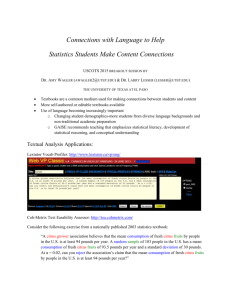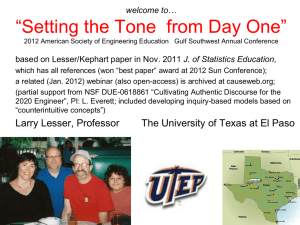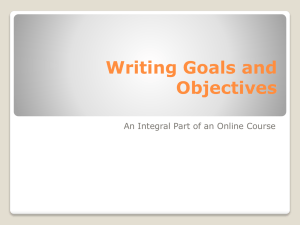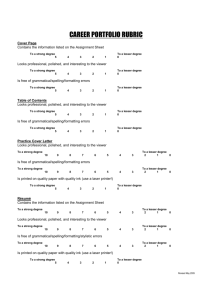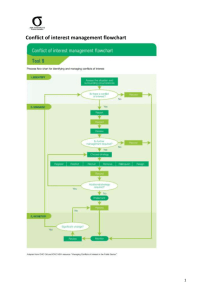3 - Mathematical Sciences - University of Texas at El Paso
advertisement
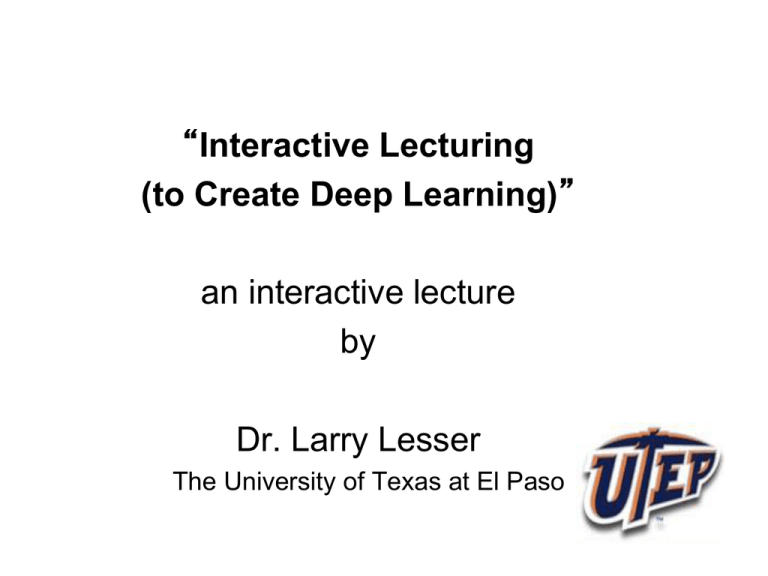
“Interactive Lecturing
(to Create Deep Learning)”
an interactive lecture
by
Dr. Larry Lesser
The University of Texas at El Paso
For a 2-choice question:
On 1-2-3, have everyone point (“not like a T-rex”)
yes
or
no
Example:
“Is this your first teaching workshop
this school year?”
Which radio wave is FM?
Pretend you’re facing a protractor
C
D
E
B
A
“ABCD voting card” (E. Prather)
to go beyond 4 choices:
• For “E”, show full page (ABCD side)
• To show your mind is “blank” (i.e., you
have no idea or don’t understand the
question), show entire blank side
2 principles of card voting
• SIMULTANEOUSLY: prepare votes and
hold them up only on the count of 1-2-3
• ANONYMOUSLY: hold cards just below
neck level
Related resources
on CETaL website
• My 11-minute 2012 video “ABCD Voting Cards”
http://vimeo.com/46773564
• Quick Reference Guide: “Using ABCD
Classroom Response Cards” compiled by
Meeuwsen
• Link to my paper in the fall 2011 Texas
Mathematics Teacher :
www.math.utep.edu/Faculty/lesser/LesserABCDcardsTMTpaper.pdf
What percent of your class meeting
time could be described as lecture?
A) 0-10%
B) 10-25%
C) 25-50%
D) 50-75%
E) 75-100%
What percent of a randomly-selected
professor’s class meeting time
could be described as lecture?
A) 0-10%
B) 10-25%
C) 25-50%
D) 50-75%
E) 75-100%
Question for you:
Why do many (mainly) lecture?
PowerPoint tip
Hitting the on/off toggle key B
(for Blackout)
forces attention inward rather than on slide
Why do many (mainly) lecture?
•
•
•
•
•
•
•
•
•
•
What we experienced in school
What (we think) our colleagues do/expect
Seems efficient
To look like we’re “working”
To feel “in control”
To be the “sage on the stage”
To make class seem orderly
To prepare/post aligned notes/handouts
Less prep time
To claim material was “covered”
QUESTION
What can be bad about lecture?
some quotes
• “College is a place where a professor’s
lecture notes go straight to the students’
lecture notes, without passing through the
brains of either” – Mark Twain
• Some people talk in their sleep. Lecturers
talk while other people sleep.” – Albert Camus
• The job is not to cover material, but to
uncover it.” – George Miller
• “I taught my dog to whistle!” “I said I
taught him, I didn’t say he learned it!” –
cartoon
QUESTION:
How might lecture be used well?
How might lecture be used well?
•
•
•
•
•
•
•
•
•
•
Motivate/challenge/arouse curiosity
How to read/organize/critique the book
Go beyond book (e.g., today’s newspaper)
Connect to research (by you or others)
In small, intentional doses
Alternated with other modalities (especially for
millenials with short attention spans)
Assess student understanding in real time
Preceded by guided pre-readings
Informed by last class’ minute papers
Accompanied by sheet to fill in (reg.; geom. prob.)
my trajectory
• 8 years as Asst/Assoc Prof (UNC, AASU)
• 2 years as HS teacher*
• 8+ years at UTEP
*typical class period: discuss HW, minilecture of new material, in-class activity,
start new HW, brief debrief/closure
I appreciate how teaching HS
made me a better professor
• Helped me identify more ways to connect to
interests of (less math-oriented) students
• reinforced that my job is to focus on the “whole
person” and student learning, not just
“covering material”
• Helped me learn why & how to lecture less
Example of real-time assessment
during HS teaching
handheld dry-erase markerboards
My goals:
make large (e.g., 40) classes more interactive for all
and assess understanding in real time
inspiration:
Dr. Kien Lim’s clicker use and May 2010 thesis by our advisee Tami Dashley
resistance (to electronic clickers):
• More dependence on tech. set up/access/support
• $ cost to students
Breakthrough:
Aug. 2010 workshop on voting cards (Prather & Brissenden, 2008)
“ABCD voting card”
Particularly important for students
not used to participating
ELLs were significantly more likely (p = .023)
than non-ELLs to agree with this statement
(from Lesser & Winsor, 2009):
“If I don’t understand what is going on in class,
I will pretend that I understand when the
instructor is looking towards me.”
Easy to pan the room
and note the modal answer:
How students get the card
• My syllabus has URL for a pdf
(thanks, Ed Prather!)
• students can print out:
in color at Library copy center (35¢)
in black & white and color it in
OR
Use of Personal Response System
(a/k/a audience response system, classroom response system)
A) I’ve used it a lot
B) I’ve used it a little
C) haven’t used it, but am open to trying it
D) haven’t used it, and doubt I will anytime soon
Implementation
• Present question (on board, PPT, oral)
and face it as you let students read it
• Announce the time they have to prepare
their votes; have them vote
• If near unanimously correct, move on;
• If not, have them “turn to your neighbor
and try to convince them you’re right” for
30 seconds, then revote
Uses
•
•
•
•
•
•
Assess conceptual understanding
Assess computational proficiency
Ask “what-if” extension questions
Estimation/simulation
Classroom management questions
Assess presence of misconceptions
besides classroom voting,
what are other techniques and issues
related to making lectures interactive?
http://courses.science.fau.edu/~rjordan/active_learning.htm
Give a “map”
•
•
•
•
Advance organizer (David Ausubel)
Outline
Concept map
Notes/slides in advance, possibly with
blanks deliberately left
• Mnemonics (not just for facts, but also for
processes)
on a micro-level:
Frayer model (word square/map)
making lecture inserts interactive
Liberating Structures (see liberatingstructures.com)
such as 1-2-4-whole group, fishbowl, speed dating, 4
corners, etc.
20 Modalities of “serious fun”: Videoclips, Games, Jokes,
Cartoons, Songs, Magic, etc. (Lesser & Pearl, 2008)
Going Beyond Classroom Walls: mini-field trips, connections to the
newspaper, culture, the lottery, etc.
Slides can become interactive demos (e.g., random rectangles, number out
of 15 unrelated words recalled, second language learner experience, etc.)
A language learner experience…
Sorto, White, and Lesser (2011)
A language learner experience…
A language learner experience…
A language learner experience…
A language learner experience…
A language learner experience…
A language learner experience…
A language learner experience…
a K1-only view of an exercise
“A ci______ g____ association believes that the
mean c______ of fresh ci_____ f_____by people
in the U.S. is at least 94 pounds per year. A
ra______ s______ of 103 people in the U.S. has
a mean c______ of fresh ci______ f ______ of
93.5 pounds per year and a standard d_______ of
30 pounds. At α = 0.02, can you r______ the
association’s claim that the mean c______ of fresh
ci_____ f______ by people in the U.S. is at least
94 pounds per year?”
Filling in K2, AWL, and offlist words
“A citrus grower association believes that the
mean consumption of fresh citrus fruits by
people in the U.S. is at least 94 pounds per
year. A random sample of 103 people in the
U.S. has a mean consumption of fresh citrus
fruits of 93.5 pounds per year and a standard
deviation of 30 pounds. At α = .02, can you
reject the association's claim that the mean
consumption of fresh citrus fruits by people in
the U.S. is at least 94 pounds per year?”
Estimate average area of the 100 rectangles:
A) < 6
B) 6-7
C) 8-9
D) 10-11
E) >11
Let’s try the‘word recall’ (positscience.com)
• 15 words
• Shown one at a time for 2 seconds each
• Pencils down until the last word is gone
rigging
volume
legend
ear
niece
sink
quarter
helpful
somewhat
throne
friend
octopus
focus
seed
short
Now, write down as
many of the 15 words
as you can recall
Count how many you got:
(avg. 20-y.o. gets 7; 80-y.o. gets 4)
•
•
•
•
•
•
•
•
Rigging
Volume
Legend
Ear
Niece
Sink
Quarter
Helpful
•
•
•
•
•
•
•
Somewhat
Throne
Friend
Octopus
Focus
Seed
Short
sentence frames (for choral reading, etc.)
“A z-score is the number of ____ ____ a value
is above the _____.”
“The p-value obtained was ___, which is
[less / greater] than our preset significance level
of ___, and therefore we [reject / fail to reject]
the null hypothesis that________.”
interactive lecture inserts
video clips (e.g., 2-minute “Probability” movie):
www.causeweb.org/resources/fun/db.php?id=226
whole-class games:
www.nbc.com/Deal_or_No_Deal/game/flash.shtml ;
http://illuminations.nctm.org/LessonDetail.aspx?id=L248
20 Fun Modalities (Lesser & Pearl, 2008)
Cartoons
Magic
Celebration days (e.g., Pi Day)
Media Bloopers
Comic Strips
Movies
Food
Music, Raps/Songs
Games (Commercial)
Poems
Games (Cultural)
Quotations
Game Shows
(Statistics) Fun Books
Humor/Jokes
Striking Examples
Kinesthetic Activity
Videos
Literature
Wordplay
Making learning “fun” is just one of many ways to increase student
engagement and motivation (I also incorporate “serious” vehicles such
as equity awareness)
(a 10-second jingle)
lyric © 2005 L. Lesser
“What p-Value Means”
tune: “Row, Row, Row Your Boat”
It is key to know
What p-value means –
It’s the chance
(with the null)
you obtain
data that’s
At least that extreme!
“Circle Song” © 2004 L. Lesser
Take your finger ‘round a jar -Circumf’rence equals 2 pi ___;
For area, you multiply
R squared by that number ___.
Twinkle, twinkle, you’re a star
Knowing math will take you___!
assessment & motivation
are connected
• Classroom voting
• Having some assessment in the form of a
game or connecting with real world,
students’ culture, etc.
• Open-ended activities and assessment and
identification of misconceptions motivate
the need to understand content better
• For HS students: TX College and Career
Readiness Standards, etc.
Assessment of Intervention
UTEP course evals for my fall 2010 Stat 1380 students:
Excellent
V. Good
Satisfactory
Poor
V. Poor
#9 (Varied use
of questions)
50
7
2
0
0
#11 (overall rating
of instructor)
54
2
2
0
0
on 11/17/10 (3 months into intervention),
3rd party (teaching center director) gives
anonymous survey to (n = 49) students
3 quantitative items on survey:
“The use of ABCD cards in this class…
• …helps me feel more engaged during class
• …gives me helpful feedback about whether
I am understanding ideas correctly when
they are presented during class
• …allows instructor to more effectively
prioritize which topics, examples, and
activities to choose during class to better
meet the students’ needs
Survey Results: Quantitative
(1 = strongly disagree; 2 = disagree; 3 = somewhat disagree;
4 = somewhat agree; 5 = agree; 6 = strongly agree)
note that 100% of the 147 responses were some form of agreement,
with 62% of them choosing the rating “strongly agree”
item
<4
4
5
6
mean
(SD)
feel more engaged
0
1
18
30
5.6 (0.5)
feedback for student
0
4
15
30
5.5 (0.6)
feedback for professor
0
3
15
31
5.6 (0.6)
Survey Results: Qualitative
30 of 49 students chose to write comments.
All comments were positive.
7 themes (in descending order of frequency):
• Makes class lively, dynamic, interesting
• Inexpensive (esp. compared to clickers)
• Gives feedback
• Plan to use it in future teaching
• Useful, practical, convenient, efficient
• Removes peer pressure or embarrassment
• Gives everyone equal chance to participate
questions for classroom voting
More examples ….
assessing “representativeness
heuristic” (Dashley, 2010)
“Which outcome of 6 coin tosses is most
likely?”
A) HHHTTT
B) TTHHTH
C) HTTHHH
D) A & B are equally likely
E) all of the above are equally likely
assessing “Learned Response”
(Dashley, 2010)
“When 3 coins are tossed,
which is the least likely outcome?”
A) 3 H
B) 2 H and 1 T
C) 1 H and 2 T
D) all of the above are equally likely
60% chance of rain means…..
(Sept. 2007 Math.Teacher media clips)
A) rain will occur 60% of the day
B) at a specific point in the forecast area, there
is a 60% chance of rain
C) 60% chance that rain will occur somewhere
in the forecast area during the day
D) 60% of the forecast area will receive rain.
“What is the most useful way to report
annual average household income?”
A) mean
B) median
C) mode
D) maximum
Find mean of {1, 2, 3, 4, 4, 16}
A) 2 B) 3.5 C) 4 D) 5 E) none of these
The above ‘optimal’ dataset is from Lesser (2011);
don’t use a dataset like {3,4,5,5,8}!
improvise “what if” questions!
“If I changed the units of X from inches to
feet, this would make the correlation
between X and Y:
“If we deleted the outlier from the dataset,
the correlation would:
A) increase, B) decrease,
C) stay the same, D) no idea.
Classroom Management
• Getting to know class: who has what
majors, year in school, etc.
• Form “groups” spontaneously
• Vote on best day to take a test or schedule
an extra office hour
• Feedback on the length or difficulty of a
test or reading
An option other than
cards or clickers:
websites like www.polleverywhere.com
(free for classes ≤ 30)
students simply use their cell phones to text their
responses and they show up on the browser
you are projecting in the classroom
Clickers vs. cards vs. texting:
factors to consider
cost, hardware, Internet, reception,
access, cheating, recording results,
anonymity, improvisation, question
types, answer types, record/displays
answers, Blackboard, tests, etc.
(Posner, 2011)
1-2-4-whole group(LS);
think-pair-share
Problem-based inquiry rich scenarios with
no single obvious answer.
(Lesser & Kephart, Nov. 2011
Journal of Statistics Education)
Which of these 5 countries did best at the
2008 Summer Olympics? (Isaacson, 2011)
Nation
Gold Silver
Bronze
Australia
14
15
17
Bahamas
0
1
1
China
51
21
28
United States
36
38
36
1
3
0
Zimbabwe
U.S. (Total Medals)
China (Gold Medals;
or by 3-2-1 weights)
Zimbabwe (medals or gold per GDP)
Bahamas (Medals Per Capita)
Australia (Medals Per Capita,
of “Major Countries”)
Who did better, Amy or Bob?
(adapted from Lesser, 2001)
fall
fall
spring
spring
TESTS
Amy
Bob
Amy
Bob
passed
1
3
3
2
taken
3
8
5
3
Who did better, Amy or Bob?
fall
fall
spring spring
Full year
Full year
TESTS
Amy
Bob
Amy
Bob
Amy
Bob
passed
1
3
3
2
4
5
taken
3
8
5
3
8
11
Find at least one answer to
“Average Class Size”
• Room 1 has 10 kids:
Al,Bob,Carl,Dee,Ed,Flo,Gil,Hal,Ivy,Jo
• Room 2 has 4 kids: Kay,Lia,Mo,Ned
• Room 3 has 3 kids: Olga,Pat,Quinn
• Room 4 has 3 kids: Ray,Sue,Ted
Average Class Size:
common answers
•
•
•
•
Room 1: 10 kids
Room 2: 4 kids
Room 3: 3 kids
Room 4: 3 kids
5 (mean), 3.5 (median), 3 (mode),
6.5 (midrange)
Average class size per…..?
mean
Class
Student
median
5
?
mode
3.5 3
? ?
class basis: {10,4,3,3}
student basis:
{10,10,10,10,10,10,10,10,10,10, 4,4,4,4, 3,3,3, 3,3,3}
Average class size per…..?
mean
median
mode
Class
5
3.5 3
Student 134/20 = 6.7 (10+4)/2 =7
10
Dataset for per-class basis: {10,4,3,3}
Dataset for per-student basis:
{10,10,10,10,10,10,10,10,10,10, 4,4,4,4, 3,3,3, 3,3,3}
and what about….
• “student-teacher ratio”? (how many teachers
hired to cover the 10,4,3,3 classes?)
• how do we count teachers’ aides? librarians?
math coach/leader/chair? part-timers?
• and for colleges: part-time students, auditing
students, hybrid courses, online courses, lab
courses, adjunct faculty, research-only faculty
COUNT THE F’s below:
DISCUSS how you could make
your lectures more interactive!
thanks for coming!
have a great weekend!
Professor Lesser
UT-El Paso
Lesser@utep.edu
example by Benjamin Tilly:
Where has my money gone?
Has my dollar turned into a penny?
$1 = 100¢ = (10¢)2 = ($0.10)2 = $0.01 = 1¢
“high-speed hypotheses!”
(e.g., Lesser, 2012; Richardson & Reischman, 2011)
•
•
•
•
•
reaction time (dom. vs. non-dom. hand)
holding a note
where people already chose to sit
estimation of how long a minute is
catching ruler released without warning
through your fingers
• Pick a number 1-10
• Which tire? (A = right front; B = left front; C = right rear; D = left rear)
• number out of 15 unrelated words recalled
Magical predictions demo to explore
multiplication rule for independent events:
Pr(A and B) = Pr(A) x Pr(B)
* An event with 1 in 2.5-billion probability?
* Predict result of a card (52-card deck),
(6-sided) die, (5-region) spinner, & coin.
Expected # of successes in the room for
each item?
Probability you got all 4 right?
